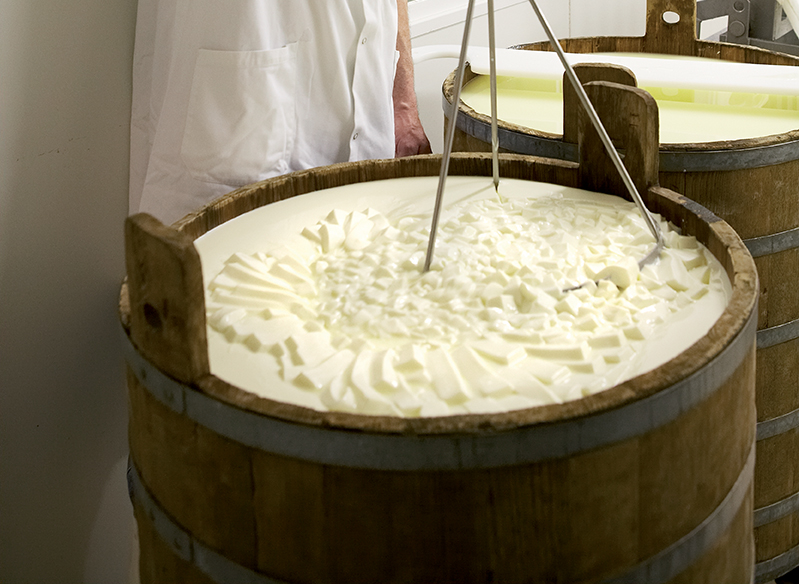
The cheese material has constantly evolved through the ages. Traditional tools also have technological interest, apart from their historical and emotional value.
The cheese material is a key element of the production. Each region has developed equipment and special tooling manufactured cheese.
The wooden gerle in the cheese.
Always use authorized in the production of Salers, the wooden gerle not only symbolic. It promotes sensory richness of the cheeses and preserves the concept of terroir and diversity. The wooden gerle plays an important role in the growth of plants and microorganisms, which is difficult with the use of stainless steel material. At the beginning of the season (summer pastures), the wooden gerle is seeded in the three weeks immersed in the whey that is renewed every day. A film microbial species settles on wood and shall return to each manufacturing part of the flora of the milk.
The copper in the cheese vat.
Widely used in the production of cooked pasta, like Beaufort, Comté or Gruyère, copper is an excellent thermal conductor that provides good heat distribution. The stainless dairy equipment give poorer results. Copper also promotes ionic exchanges with the milk of quality. Indeed, the copper ions move in milk and act as activators or inhibitors during the fermentation, flavor-improving cheeses. The flavor of the cheeses produced in copper tubes is better than in stainless steel tanks since copper causes enzymatic reactions with milk.
The regulation of the dairy equipment.
There is no prescribed materials for the manufacture of cheese. This is the general regulation on materials suitable for food contact which is applied with a special feature: the possibility to request an exemption for traditional materials such as wood.
Long wooden, the cheese equipment was the era of the instruments of aluminum, a material that works easily and is inexpensive. It has practically disappeared because the detergents damaged and because it loses particles in milk. Only milk cans are still made of aluminum, because stainless steel is brittle and that the plastic poses bacteriological problems because of its porosity.
The mold in the cheese.
The mold must adapt to manufacturing, the volume of the curd and the drip capacity. The mold is a material that provides the shape and desired weight for cheese. There are two main types of molds: that soft cheeses and that of hard cheeses. Soft paste, there is used a mold assembly composed of the plate, the blind, the mold block and the socket. Pasta pressed, the equipment used in cheese is limited to individual molds or micro-perforated block molds. Traditional materials wood and aluminum are complicated to clean and have almost disappeared.
The ladle in the cheese.
In some cases, the right equipment cheese just begins with the ladle, whose use for molding preserves the curd. Indeed, the ladle is a material that prevents breaking the curd and therefore allows for a slow drip to obtain a soft texture. Some cheeses must have a soft dough and therefore avoid pre-drained curd or broken by inadequate tools.
Shovel in the cheese.
The use of the shovel is compulsory cheese material for production of Brie de Meaux. Brie shovel can cut the curd horizontally and gently place the curd in thin layers in pan. The manual use of this material to affect the texture of the cheese. As with the ladle, this is not to break the curd to prevent pre-draining, which gives a dry cheese.
The maturing on wooden cheese.
Many studies confirm that this microbial flora on wooden ripening shelves limit the growth of Listeria. The wood is used in many sectors maturing cellars like cheese Reblochon, Comté, Munster, Ossau Iraty ... This is a traditional material that contributes to the typical cheeses. The wood can even eliminate pathogenic microbes: it somehow immunizes cheese. Furthermore, the timber also plays a role in terms of control because it absorbs water and constantly restores moisture.
The withdrawal of the curds in cheese cloth.
The material of a cheese often include a web to fulfill three functions: enable draining of the curd during pressing by facilitating drainage, protect the cheese avoiding dryness and finally create an impression of crust which promotes the establishment of the morge early ripening.